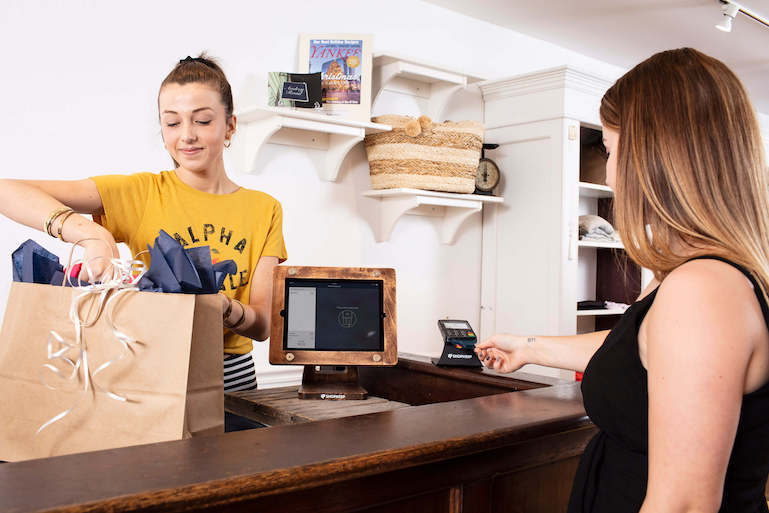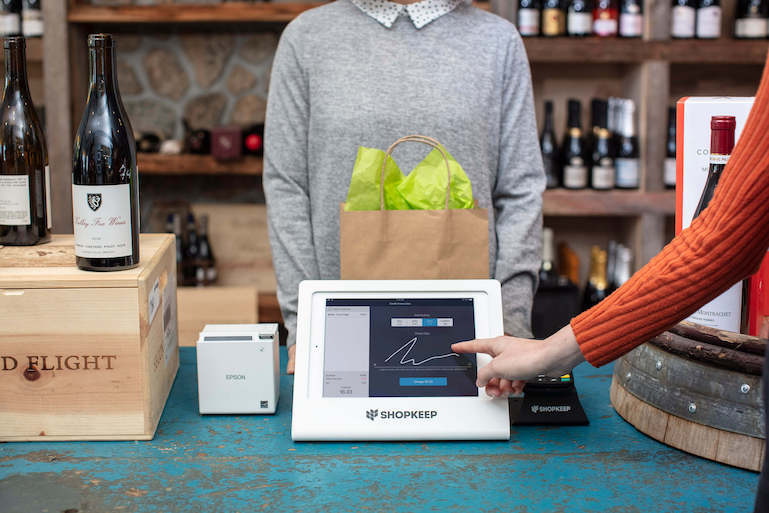
Proven Ways To Close a Sale in Retail
We don’t have to tell you that sales are important. But knowing how to close a sale in retail is a specialized skill, one that combines industry expertise with an understanding of human psychology.
Most importantly, the ability to close sales is a skill that can be learned. So we pulled together the top science-based tactics proven to boost profits at your store.
Set The Stage For Sales
The first step in closing a sale is creating an environment where customers feel welcome.
From the color scheme to the music to the scent, every aspect of your store’s decor should evoke a pleasant emotional response in your customers.
And then there is your shop’s layout. Most retail stores follow tried-and-true layouts to showcase merchandise, and each layout can be optimized to increase sales. Get inspired by beautiful examples of real store layouts and then study different layouts to see how each one can be “hacked” to convince customers to buy more.
SEE ALSO: Simple But Effective Boutique Store Design Tips
Hire and Reward the Right Sales Staff
If you rely on employees to close sales, hiring and training the right sales reps is crucial for your shop’s success. Your first hires are especially critical for surviving the first year of small business ownership.
You’re in luck, because retail is the most popular industry for hourly workers. Research shows that these workers want to get enough hours, earn fair wages, have opportunities for advancement, and work close to home.
If you need an employee for 30 hours a week, it may be tempting to hedge your bets by hiring two workers for 15 hours a week. But in order to retain quality talent who can close sales, consider hiring one dedicated worker for 30 hours a week instead, and paying her or him a small commission on top of their hourly rate.
Look for individuals who have a passion for your industry, whether you own a clothing boutique or a hardware store, and try to hire social learners. Your staff should enjoy meeting new people, and come across as trustworthy and empathetic.
A big part of retaining quality salespeople is rewarding them well, so make sure you have a way to track and reward your best employees.
SEE ALSO: Hiring and Employee Checklist: Everything You Need to Know
Start Positive
When a potential customer enters your store, you or your salesperson shouldn’t be stuck behind the counter or tied up in an aisle. You should be mobile and ready to engage the sales process.
Greet but don’t approach your prospect right away. Instead, wait fifteen seconds so they can decompress and take in their surroundings. Then approach them with a positive comment. It can be about the weather or about the customer’s shoes. But keep it light and upbeat.
Speaking of shoes…
Put Yourself In Your Customer’s Shoes
At its core, closing a sale is convincing another person to take a specific action. And studies have shown that the best way to do this begins with attunement. Take the time to adopt your customer’s point of view, with a focus on understanding their thoughts instead of feelings. Assume the prospect is the one with the power (because, let’s be honest, they are). If you do this, you’ll appear sincere as your body language begins to naturally mimic the customer’s gestures, putting your prospect at ease.
Focus on Problem Solving
By listening closely to why the customer walked into your store, you can solve their problems with your products. Focus on the value of your products, not the price. That’s the difference between “this dress will be perfect for your sister’s wedding this weekend” and “this dress is on sale.”
The fact is, with the advent of online retail, most brick-and-mortar retailers cannot compete on price alone. Customers are more sophisticated; we’ve seen people step into a brick-and-mortar store to check out merchandise with one hand while searching on Amazon for a better deal with the other. Today’s customers don’t lack information. What they lack is guidance.
According to Inc., “about one-third of consumers are purely hung up on price, while the other two-thirds are open to at least hearing your argument.” You believe in your product, so speak confidently about how it will benefit your customer’s life.
Never Trash Talk the Competition
It’s tempting to prove how superior your products are by speaking ill of the competition. But due to a curious phenomenon called spontaneous trait transference, the customer will actually associate those negative traits with your products, killing the sale. Don’t go into the fact that the toy store across town sells poorly-made, plastic toys. Instead, talk about how your locally-produced, wooden toys are heirloom quality.
Suggest Complementary Merchandise
A big mistake many salespeople make is ending the sale too soon. Suggest additional merchandise that complements what the customer has chosen to achieve valuable add-on sales.
For example, instead of closing the sale with an immediate “I’ll ring this shirt up for you,” recommend items that complement the customer’s decision, like a scarf that matches said shirt. The customer is already in a buying mood, and you know your merchandise—and how it will benefit your customer—better than anyone.
Many articles have been written on the power of suggestive selling techniques, and there are a few best practices to follow.
Suggest items of lesser value, and make sure the suggested item increases the customer’s satisfaction with their overall shopping experience. In the end, suggestive selling is not only about making more money by selling more merchandise. It’s about turning a customer into a regular by delivering personalized service.
Save the Sale
In most cases, customers end a sale themselves by checking out. But you may find yourself in a situation where you need to resort to stronger techniques to save the sale. We don’t recommend using these regularly because they reflect poorly on your retail business as a brand and can be seen as pushy. But in select cases, a few old-fashioned retail sales tips come in handy:
Create urgency. “This wrench is only on sale until Friday” or “this is the last skirt we have in your size” might make the buyer more likely to close the deal.
Toss in a free item. “That suit is so perfect for you, I’ll throw in this tie for free.” This sort of off-the-cuff transaction requires you to have an almost encyclopedic knowledge of your merchandise.
Assuming the sale. “I’ll gift wrap this for your dad,” you might say to someone shopping around the holidays, heading toward the gift-wrapping station. At that point, it’s more difficult for the customer to stop you and therefore stop the sale. This is known as the assumptive close.
However, consistently relying on stronger sales techniques like the ones above can cause the customer to leave your shop feeling like they were pushed into a sale, and ending sales on a negative note is ultimately bad for business. Which brings us to our last point.

End the Process on a Positive Note
Studies show that the end of an interaction strongly impacts the way people view an experience. So if ringing your customer up is beset by technical issues, or you can’t accept their payment method, or they have to wait in a long line to check out, they will leave your store feeling frustrated and may not return.
This is a major reason why a reliable point of sale system is absolutely essential. Your POS should accept modern payment methods, including all credit cards and apple pay, and offer features like rewards programs to boost repeat sales. Make the end of a sale even more seamless by having an employee walk around with a small tablet that accepts credit cards and bypass long lines altogether.
By setting the stage for the sale, following science-based retail sales techniques, and keeping interactions positive, you can increase retail sales at your business while boosting customer satisfaction. And that’s a recipe for retail success.
Want to try ShopKeep for yourself?
Just answer a few easy questions.
Need help finding the right point of sale?
Just complete the form. We’ll call you right back to explain how ShopKeep can work for you.
Hit the ground running.Sprinting, in fact!
Read our free, comprehensive guide, Small Business 101, to learn all you need to know about starting a thriving business.

